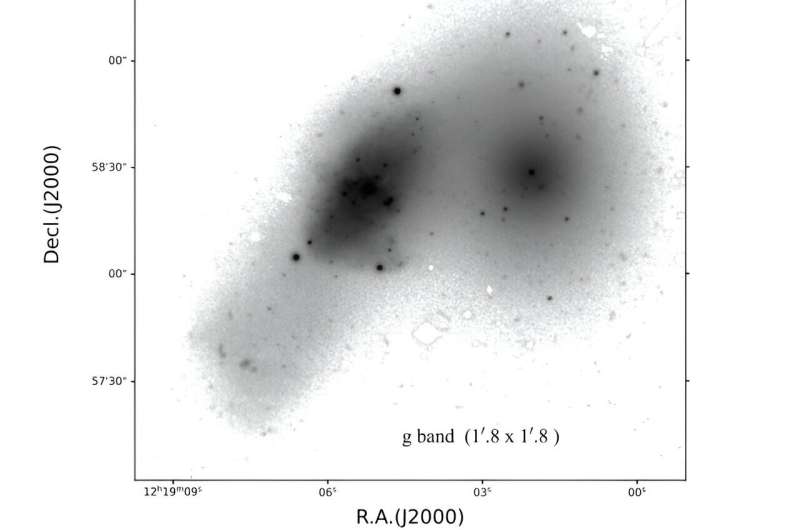March 12, 2024 report
This article has been reviewed according to Science X's editorial process and policies. Editors have highlighted the following attributes while ensuring the content's credibility:
fact-checked
preprint
trusted source
proofread
Observations explore the nature of merging dwarf galaxy VCC 322

Using the Canada France Hawaii Telescope (CFHT), Chinese astronomers have performed multi-band observations of a merging dwarf galaxy known as VCC 322. Results of the observational campaign, presented March 4 on the preprint server arXiv, deliver crucial information regarding the nature and properties of this galaxy.
Dwarf galaxies, with masses below 5 billion solar masses, contain up to several billion stars and are the most numerous galaxies in the universe. Their formation and activity are assumed to be heavily influenced by interactions with larger galaxies.
Although mergers of dwarf galaxies are expected to occur at all redshifts, they are still not fully understood, mainly due to the observational challenges of such events. However, there is evidence that dwarf mergers play a significant role in triggering star formation in the nearby universe.
VCC 322 is a dwarf irregular galaxy in the Virgo cluster with an estimated mass of about 90 million solar masses. Previous observations have found that the galaxy has tidal tails and stellar shells, which points to a merger remnant. Moreover, VCC 322 may also be interacting with early type dwarf galaxies designated VCC 319 and VCC 334.
A team of astronomers led by Lan-Yue Zhang of the University of Chinese Academy of Sciences in Beijing, China, has taken a closer look at the ongoing merger of VCC 322. For this purpose, they obtained broadband optical images of this galaxy using CFHT. Their study was complemented by data from the Dark Energy Camera (DECam) on the Blanco 4m telescope.
"We conduct a comprehensive study on VCC 322, a merger remnant which might form a triple system with VCC 334 and VCC 319, using multi-band photometric data and optical spectrum," the researchers wrote in the paper.
The observations revealed that VCC 322 has a prominent long straight tidal tail. This tail has a size comparable to the host galaxy, and its stellar age is estimated to be about 10 billion years.
The study found that the old population of stars (at least 1 billion years old) contributes most to the stellar mass of VCC 322. When it comes to the young population (younger than 100 million years) contributes most to the galaxy's luminosity.
Further analysis of the data suggests that VCC 322 is a disk galaxy whereas VCC 319 is an early type object. Moreover, VCC 319 appears to showcase isophotal twisting, which indicates that it is likely interacting with VCC 322.
The observations also revealed an ongoing star formation activity in VCC 322. However, the star formation in this galaxy seems suppressed when compared to other known star-forming dwarfs of similar stellar mass in the Virgo cluster. The authors of the paper assume that a merger/interaction–induced shock probably causes gas heating, suppressing the star-formation activity in VCC 322.
More information: Lanyue Zhang et al, A study of the merging dwarf galaxy VCC322, arXiv (2024). DOI: 10.48550/arxiv.2403.01764
Journal information: arXiv
© 2024 Science X Network




















